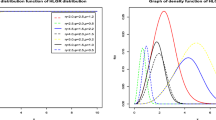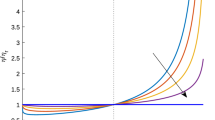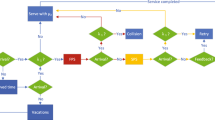Abstract
In this paper we demonstrate how tree-like processes can be used to analyze a general class of priority queues with three service classes, creating a new methodology to study priority queues. The key result is that the operation of a 3-class priority queue can be mimicked by means of an alternate system that is composed of a single stack and queue. The evolution of this alternate system is reduced to a tree-like Markov process, the solution of which is realized through matrix analytic methods. The main performance measures, i.e., the queue length distributions and loss rates, are obtained from the steady state of the tree-like process through a censoring argument. The strength of our approach is demonstrated via a series of numerical examples.
Similar content being viewed by others
References
A.S. Alfa, Matrix-geometric solution of discrete time MAP/PH/1 priority queue. Naval Research Logistics 45 (1998) 23–50.
A.S. Alfa, B. Liu, and Q.M. He, Discrete-time analysis of MAP/PH/1 multiclass general preemptive priority queue. Naval Research Logistics 50 (2003) 662–682.
D.A. Bini, G. Latouche, and B. Meini, Solving nonlinear matrix equations arising in tree-like stochastic processes. Linear Algebra Appl. 366 (2003) 39–64.
Q. He, Queues with marked customers. Adv. in Appl. Probab. 28 (1996) 567–587.
Q. He and M.F. Neuts, Markov chains with marked transitions. Stochastic Processes and their Applications 74 (1998) 37–52.
G. Latouche and V. Ramaswami, Introduction to Matrix Analytic Methods and Stochastic Modeling. SIAM, Philadelphia, 1999.
F. Machihara, On the queue with PH-Markov renewal preemption. J. Oper. Res. Soc. of Japan 36 (1993) 13–28.
D.G. Miller, Computation of steady-state probabilities for M/M/1 priority queues. Operations Research 29(5) (1981) 945–958.
R. Miller, Priority queues. Annals of Mathematical statistics 31 (1960) 86–103.
M.F. Neuts, Matrix-Geometric Solutions in Stochastic Models, An Algorithmic Approach. Johns Hopkins University Press, 1981.
M.F. Neuts, Structured Stochastic Matrices of M/G/1 type and their Applications. Marcel Dekker, Inc., New York and Basel, 1989.
V. Ramaswami, The generality of QBD processes. In Advances in Matrix Analytic Methods for Stochastic Models, Notable Publications Inc., Neshanic Station, NJ, 1998, pp. 93–113.
T. Takine, A nonpreemptive priority MAP/G/1 queue with two classes of customers. J. Oper. Res. Soc. of Japan 39(2) (1996) 266–290.
T. Takine and T. Hasegawa, The workload in a MAP/G/1 queue with state-dependent services: Its applications to a queue with preemptive resume priority. Stochastic Models 10(1) (1994) 183–204.
T. Takine and T. Hasegawa, The nonpreemptive priority MAP/G/1 queue. Operations Research 47(6) (1999) 917–927.
T. Takine, B. Sengupta, and R.W. Yeung, A generalization of the matrix M/G/1 paradigm for Markov chains with a tree structure. Stochastic Models 11(3) (1995) 411–421.
B. Van Houdt and C. Blondia, Tree structured QBD Markov chains and tree-like QBD processes. Stochastic Models 19(4) (2003) 467–482.
B. Van Houdt and C. Blondia, Throughput of Q-ary splitting algorithms for contention resolution in communication networks. Communications in Information and Systems 4(2) (2005) 135–164.
R.W. Yeung and A.S. Alfa, The quasi-birth-death type Markov chain with a tree structure. Stochastic Models 15(4) (1999) 639–659.
R.W. Yeung and B. Sengupta, Matrix product-form solutions for Markov chains with a tree structure. Adv. in Appl. Probab. 26 (1994) 965–987.
Author information
Authors and Affiliations
Corresponding author
Additional information
AMS Subject Classifications Primary—60K25; Secondary—60M20, 90B22
Rights and permissions
About this article
Cite this article
Houdt, B.V., Blondia, C. Analyzing priority queues with 3 classes using tree-like processes. Queueing Syst 54, 99–109 (2006). https://doi.org/10.1007/s11134-006-8804-0
Received:
Revised:
Issue Date:
DOI: https://doi.org/10.1007/s11134-006-8804-0




